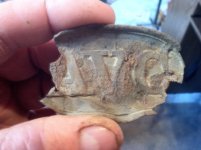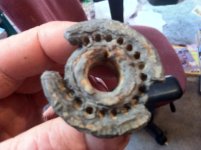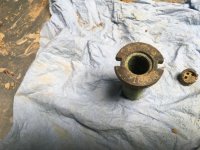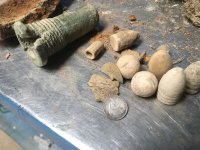mxdigger
Jr. Member
- Jun 30, 2013
- 31
- 58
- Detector(s) used
- Nautilus DMC 2B, Minelab Musketeer Xs pro, AT Pro, Garrett pro pointer, Xp Deus with pin pointer
- Primary Interest:
- Relic Hunting
I've been trying to figure out what this thing is trying to tell me but the more I try the worse it gets. I've hunted with an AT Pro for the past 6 or 7 years and that machine was probably the easiest machine I ever tried to learn. I could pretty much tell what it was before ever digging and found a ton of stuff with it.
It was getting old and I figured it couldn't last forever so I was thinking about a new one and really thinking about the newer AT Max. Just about the time I was getting ready to buy a friend of mine ran into hard times and asked if I wanted to buy his only used a few times Deus. He needed $ 800.00 but I gave him a grand because I knew he needed it.
That was about 4 months ago. I spent a month or more reading everything I could find about the machine and in the meantime got out in the woods with it every chance I got trying to get a grip on it. I tried the factory programs even put in a few programs I got out of some of the books I read. The problem I seem to have is that no matter what I do everything under the coil sounds the same. Now I know that trying to hunt a trashy site is not the best way to try to learn a new machine but where in VA. are you going to find a site with relics that is not trashy?
I went out to a spot I've been wanting to try for a long time yesterday with several different home sites dating back to the early 1700's. We were out there from sunup to after dark and never did get to the last one. Two of the house sites are in the grown-up woods which would lead to more problems, but I have hunted sites like that with my other machines before with good results. With this XP I could never tell what trash was and what was possibly something good because everything sounded so good, I had to dig it. The whole day I spent digging a 55-gal trash bag of nothing but rusty iron, Alum cans, and bottle caps. I'm not ragging on the XP because I know they are good machines but I'm having one heck of a time trying to figure it out. I also know it's probably my fault and I'm just missing something but just don't know what it is. Can someone that has one of these XP's give up a few hints on how they learned their machine.
It was getting old and I figured it couldn't last forever so I was thinking about a new one and really thinking about the newer AT Max. Just about the time I was getting ready to buy a friend of mine ran into hard times and asked if I wanted to buy his only used a few times Deus. He needed $ 800.00 but I gave him a grand because I knew he needed it.
That was about 4 months ago. I spent a month or more reading everything I could find about the machine and in the meantime got out in the woods with it every chance I got trying to get a grip on it. I tried the factory programs even put in a few programs I got out of some of the books I read. The problem I seem to have is that no matter what I do everything under the coil sounds the same. Now I know that trying to hunt a trashy site is not the best way to try to learn a new machine but where in VA. are you going to find a site with relics that is not trashy?
I went out to a spot I've been wanting to try for a long time yesterday with several different home sites dating back to the early 1700's. We were out there from sunup to after dark and never did get to the last one. Two of the house sites are in the grown-up woods which would lead to more problems, but I have hunted sites like that with my other machines before with good results. With this XP I could never tell what trash was and what was possibly something good because everything sounded so good, I had to dig it. The whole day I spent digging a 55-gal trash bag of nothing but rusty iron, Alum cans, and bottle caps. I'm not ragging on the XP because I know they are good machines but I'm having one heck of a time trying to figure it out. I also know it's probably my fault and I'm just missing something but just don't know what it is. Can someone that has one of these XP's give up a few hints on how they learned their machine.













